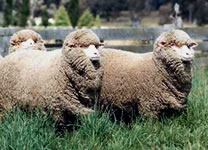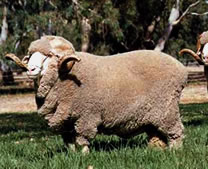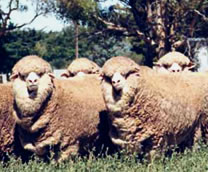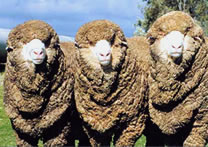Merino
The Australian Merino
The modern Merino can be classified into four types according to the wool. It produces – superfine, fine, medium and strong. Each is bred to suit a particular set of climatic conditions, and is characterised by a large quantity of soft-handling wool grown on an angular frame. Poll Merinos are represented in all categories.
Further information is available from:
The Australian Merino Centre
Level 2 RAS Admin Building
1 Showground Road
Homebush Bay NSW 2127
www.merinos.com.au

Superfine and Fine-wool Merino
These sheep are found mainly in the northern, central and southern tableland areas of New South Wales; the western districts of Victoria; and the midlands district of Tasmania. Superfine and Fine wool Merinos have a small frame and produce a special wool of excellent colour, which is soft-handling and dense.
Superfine has a fibre diameter of 18 micro ns or less and Fine-wool is 19 microns. They have a staple length of about 70mm and 75mm respectively. Both Superfine and Fine-wools are used for high quality worsted suiting and fine knitting yarns. The Australian flock has ‘fined up’ considerably over the past few years, ultrafine wool (less that 15.6 micron) is also produced in reasonable quantities.

Medium-wool Merino
This strain is found in large numbers throughout New South Wales, Queensland, Victoria and Western Australia. They are large framed and relatively plain bodied, giving them a dual-purpose role. Grown primarily for wool production, the medium-wool merino also has an acceptable carcase form, giving them an additional meat producing role.
The medium-wool Merino produces a wool that is almost totally absorbed by the textile trade, where it is turned into high quality apparel wool. It produces a heavy fleece which is soft-handling and of good colour, with a fibre diameter of 20 to 22 microns and a staple length of around 90mm. The medium-wool Merino is extensively used in the production of F1 crossbred ewes by mating long-wool meat rams to the Merino ewe. The Border Leicester in particular is used for this purpose, although the Romney, Perendale, East Friesian and others are also used.

Strong-wool Merino
This strain is found in large numbers throughout New South Wales, Queensland, Victoria and Western Australia. They are large framed and relatively plain bodied, giving them a dual-purpose role. Grown primarily for wool production, the medium-wool merino also has an acceptable carcase form, giving them an additional meat producing role.
The medium-wool Merino produces a wool that is almost totally absorbed by the textile trade, where it is turned into high quality apparel wool. It produces a heavy fleece which is soft-handling and of good colour, with a fibre diameter of 20 to 22 microns and a staple length of around 90mm. The medium-wool Merino is extensively used in the production of F1 crossbred ewes by mating long-wool meat rams to the Merino ewe. The Border Leicester in particular is used for this purpose, although the Romney, Perendale, East Friesian and others are also used.

Poll Merino
Poll Merinos are a more recent development in the Merino breed, with some producers selecting for this recessive gene. Poll Merino wethers are less prone to fly-strike in the poll area than those with horns and are easier to handle at shearing and crutching time. The Poll Merino is scattered throughout all Merino producing areas and is represented within all strains of Merino.